![]()
![]()
![]()
Use LEFT and RIGHT arrow keys to navigate between flashcards;
Use UP and DOWN arrow keys to flip the card;
H to show hint;
A reads text to speech;
25 Cards in this Set
- Front
- Back

q
|
Tobias and the Angel
c 1473 possible contribution to the painting by Andrea del Verrocchio and his studio. London, National Gallery A typical painted product of Verrocchio's studio, clearly exhibiting the work of different hands, one of which may be Leonardo's. If so, the vividly painted fish is the best candidate for his intervention. |
|
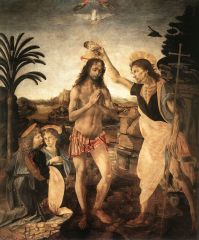
a
|
THE BAPTISM OF CHRIST
contribution to painting by Andrea del Verrocchio, Florence, Uffizi c.1476 Earlv sources attest to Leonardo adding an angel (the one nearest the spectator) to the painting made for San Salvi in Florence. The distant landscape, the water, and the oil glazes over much of the surface of the painting also bear clear signs of his intervention. |
|
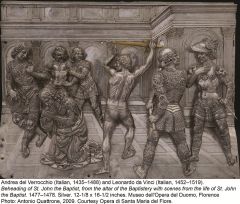
q
|
BEHEADING OF ST JOHN THE BAPTIST
Silver relief from the Altar for the Florentine Baptistery commissioned 1478 The complex poses, sharp characterization, and refined naturalistic detail in the figures of the youth with the salver and the belligerent foreground warrior suggest strongly that Leonardo contributed these small statuettes to be assembled with the other components for Verrocchio's powerful narrative relief. |
|

q
|
ANNUNCIATION
Florence, Uffizi c. 1474 Leonardo's earliest known independent painting, compiled using motifs from Verrocchio's repertoire, and with a laborious perspectival scheme, but with passages of observation and an intensity of representation that are highly original. |
|

q
|
MADONNA AND CHILD WITH A CARNATION
Munich, Alte Pinakothtk c. 1476 Highly ambitious and straining uncomfortably for effect (not least in its use of the oil medium), this shows Leonardo's first steps in reanimating the genre of the Virgin and Child. The landscape may reflect his interest in Netherlandish art. |
|
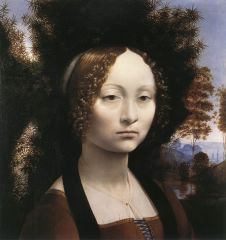
q
|
GINEVRA DE' BENCI
with painted reverse, Washington, National Gallery of Art c. 1478 The sitter was a member of the circle of Lorenzo il Magnifico in Florence and subject of courtly poems celebrating the love she had aroused in Bernardo Bembo, Venetian Ambassador. The set-up of a Verrocchio sculpted bust is combined with brilliant naturalism of surface effect and atmosphere. The emblematic motif on the reverse ("virtutem forma decorat") shows that the bottom of the picture has been cut off, and probably contained the sitter's hands. |
|
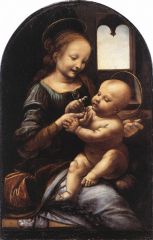
q
|
MADONNA AND CHILD (THE BENOIS MADONNA)
St Petersburg, Hermitage c. 1480 A very small, concentrated painting in which Leonardo has endowed the relationship between mother and child with new complexity, energy, and intensity of emotional reaction.'The composition results from his innovatory, 'brainstorm' drawing style. |
|
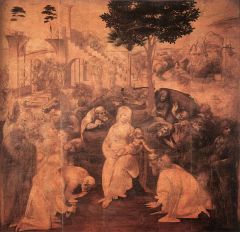
q
|
ADORATION OF THE MAGI
Florence, Uffizi c. 1479-81 Subject of a written document in 1481, setting out the complex terms of the commission, the large panel for San Donato a Scopeto, outside Florence, was left unfinished when the painter left for Milan. He has laid down the essential ingredients of what was to be called the High Renaissance style in the combination of great figural complexity with majestic compositional orchestration. |
|
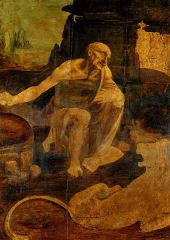
q
|
ST JEROME
Vatican c. 1480-82 Presumably undertaken in parallel with the Adoration and left in a comparable state of unfinish. It exploits Leonardo's studies of the anatomy of oldish and thin figures, as recorded in his list of works from around 1481. |
|
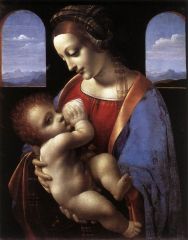
q
|
MADONNA LITTA, WITH GIOVANNI ANTONIO BOLTRAFFIO (?)
St Petersburg, Hermitage c.1481—97 Leonardo was working on a Madonna in profile around the time of his departure for Milan, but the painting was (to judge from drawings attributable to Boltraffio) substantially brought to completion by Leonardo's pupil in the master's Milanese workshop. |
|

q
|
VIRGIN OF THE ROCKS
Paris, Louvre 1483- c. 1490 Commissioned in 1483 by the Milanese Confraternity of the Immaculate Conception for their large sculpted altarpiece in their chapel in San Francesco Grande in Milan, as part of a series of painted components and polychroming by Leonardo and the brothers Evangelista and Giovanni da Predis. A protracted and horribly complex dispute ensued, which was only resolved in 1508 with the placing in the altarpiece of what seems to be the London version. The picture now in Paris may have been intercepted by Ludovico Sforza before its delivery to the Confraternity. The treatment of light, shade, and colour shows how Leonardo reformed their relationship in painting, using tonal description (i.e. the scale between white and black) as the basis of the definition of form, |
|
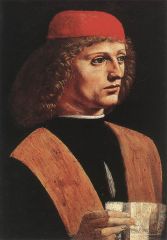
q
|
MUSICIAN (unfinished)
Milan, Ambrosiana c. 1483 Although the sitter has not definitely been identified, and the attribution is disputed, the modelling of the face and the intensity of the eyes support Leonardo's authorship. |
|

q
|
CECILIA GALLERANI (THE LADY WITH THE ERMINE)
Cracow, Czartoryski Museum c.1490 Cecilia was Ludovico Sforza's mistress for two years or so as a young woman of artistic accomplishments. The ermine puns on her name (Galec Greek) and speaks of her purity, since the ermine would supposedly die rather than soil its white winter coat. The sense of the sitter reacting to an unseen presence is unprecedented, as is the parallel between the gracious deportment of the woman and the oversized weasel. |
|

q
|
VIRGIN OF THE ROCKS
with his studio, London, National Gallary c. 1493-1508 This is the painting that came from the altarpiece in San Francesco Grande, and was presumably the one eventually provided in 1508. Although there may be studio intervention in subsidiary parts of the picture, the figures are entirely consistent with Leonardo's style in the mid-1490 in Milan, when he presumably began the 'replacement' version. Areas of the flesh show the finger-print technique that is widely apparent in his works before 1500. Technical examination has revealed that Leonardo considered a revised figure arrangement before reverting to the original composition. |
|

q
|
PORTRAIT OF LADY ('LA BELLE FERRONIERE')
Paris, Louvre c.1497 Reasonably identified as the portrait o fLucrezia Crivelli, mistress of Ludovico in the later 1490s. The slightly averted glance testifies to Leonardo's conception, and much of the picture is finely executed, though the studio may have contributed to some of the more routine details. |
|

q
|
LA BELLA PRINCIPESSA (PORTRAIT OF BIANCA SFORZA?)
Private Collection, c.1496 This tender and refined formal portrait in ink and coloured chalks on vellum has been cut from a codex (a book), namely the copy of the Sforziada in Warsaw produced for Galeazzo Sanseverino. Leonardo researched the unusual technique by asking the French King's painter, Jean Perreal, about his method of 'dry colouring.' The sitter is one of the Milanese 'princesses,' with her hair dressed in what became the obligatory style, and is Bianca, Ludovico il Moro's illegitimate daughter, who married Galeazzo and died in her early teens in 1496. |
|

q
|
LAST SUPPER
Milan, Refectory of Sta Maria delle Grazie 1498 A letter from Ludovico to his secretary in 1497 asks that Leonardo should be pressed to complete the mural. Painted experimentally in a technique more like tempera (using an egg binder) rather than traditional fresco (painted into wet plaster), it was subject to paint loss from an early date. The restoration at the end of the twentieth century disclosed striking details but confirmed how little of Leonardo's original paint survives in many areas of the picture. The eloquence and grandeur of the narrative set new standards lor 'history painting'. |
|

q
|
SALA DELLE ASSE
with assistants, Milan, Castello Sforzesco c.1498-99 We know that Leonardo was working in the large corner room in the castle in 1498. The trees originally arose from rock-entangled roots, and intertwined with a gold rope in a complex knot motif, interspersed with Sforza heraldic shields. The decorative scheme survives only in a fragmentary and reworked form. |
|
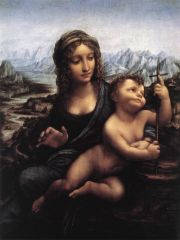
q
|
MADONNA OF THE YARNWINDER (THE 'LANSDOWNE MADONNA')
With pupils, private collation c. 1501-07 Leonardo was documented as working on a small picture of this subject in 1501, after his return from Florence. The Patron was Florimond Robertet, Secretary of State to successive French kings. He appears to have received his picture in Blois in 1507. Technical examination has revealed strikingly complex and similar underdrawings in both versions, indicating Leonardo's direct involvement in making two pictures of this subject. Which went to Robertet is presently unclear. |
|

q
|
MONA LISA
Paris, Louvre c. 1503-1516 The sitter can with some confidence be identified as Lisa Gherardini, wife of Francesco del Giocondo, a prominent Florentine citizen. The painting was underway in 1503, when it was mentioned by Agostino Vespucci. It was seen in Florence by Raphael, amongst others, but it appears to have been brought to its present state much later, and remained with Leonardo until his death. |
|

q
|
SALVATOR MUNDI
Private collection c.1507 Known previously through drapery drawings at Windsor, copies and engravings, and having passed through the collection of Charles I, the original has now reappeared. It has been damaged and restored, but still makes a powerful impression. The traditionally frontal stare of the 'Saviour of the World' has gained a new psychological complexity from Leonardo's sfumato. He has also used rock crystal with sparkling inclusions for the orb to denote the crystalline sphere of the fixed stars. |
|

q
|
ST JOHN THE BAPTIST
Paris, Louvre c.1508-16 Derived from a lost Leonardo painting of the3 Angel of the Annunciation, St John pronounces the arrival ol Christ directly to the spectator, exuding an air of cosmic mystery. The darkened state of the picture makes its original effect hard judge. |
|
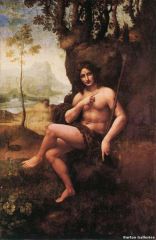
q
|
BACCHUS (BEGUN BY LEONARDO AS A ST JOHN?)
Paris, Louvre 1513-16 In its present state, transformed into Bacchus, the picture seems to show little that could be by Leonardo, yet the pose and draughtsmanship of the saint's figure are beyond anything that pupils and followers accomplished. |
|

q
|
MADONNA, CHILD, ST ANNE, AND A LAMB
Paris, Louvre c. 1508-17 The culmination of a series of essays on the theme in drawings and cartoons, this is probably Leonardo's last painting. The fluency of figure movement, emotional complexity, and atmospheric magic stand at the climax of Leonardo's synthesis of natural effects and exploitation of fantasia for the communication of subtle meaning. |
|
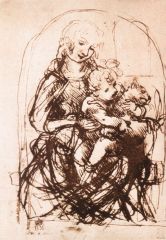
q
|
q
|

